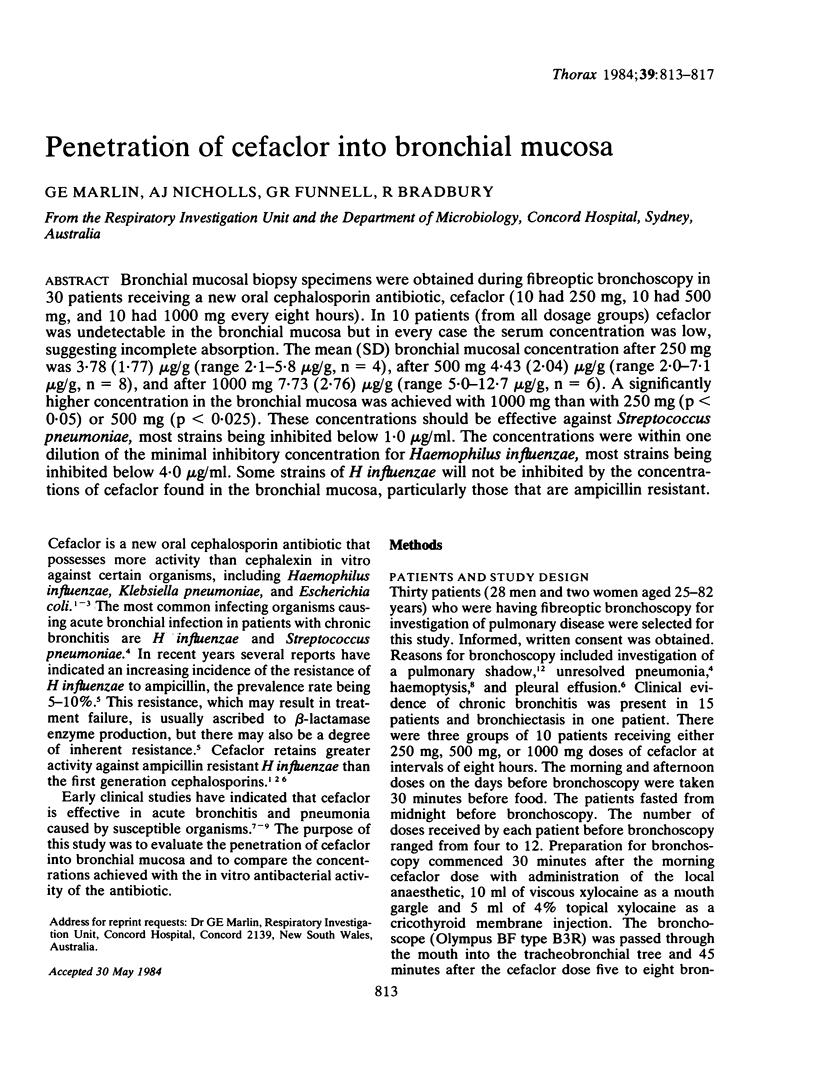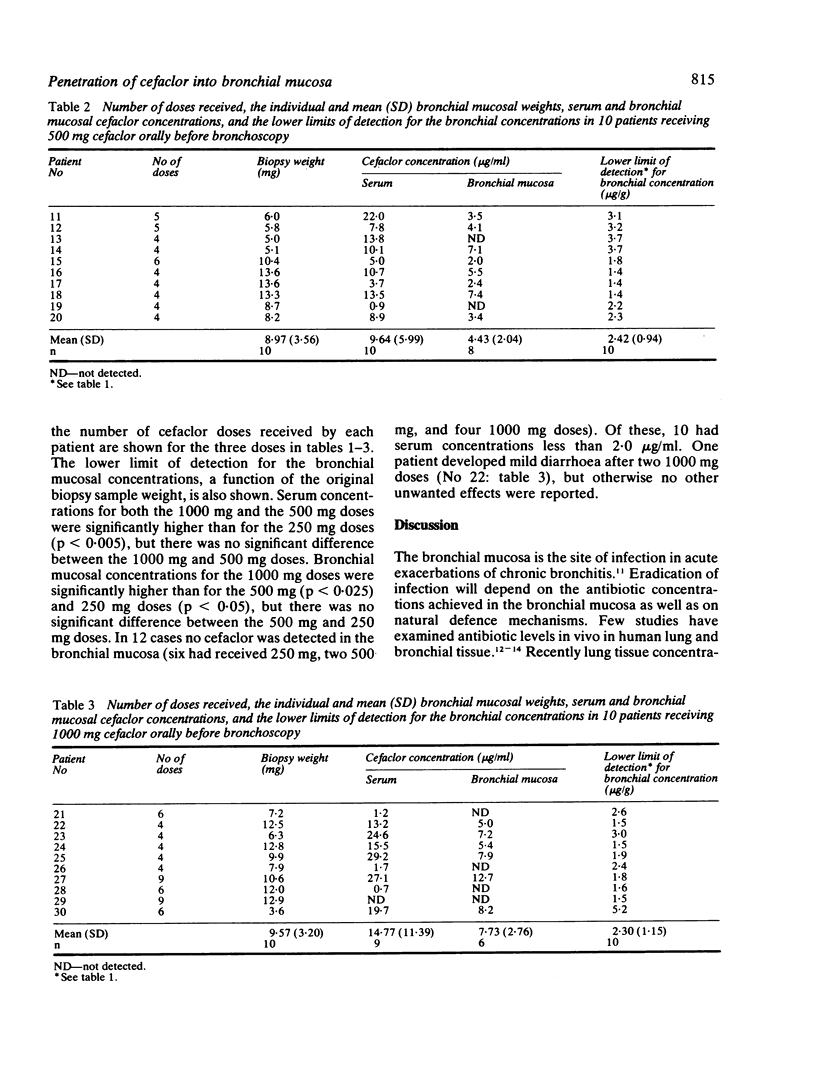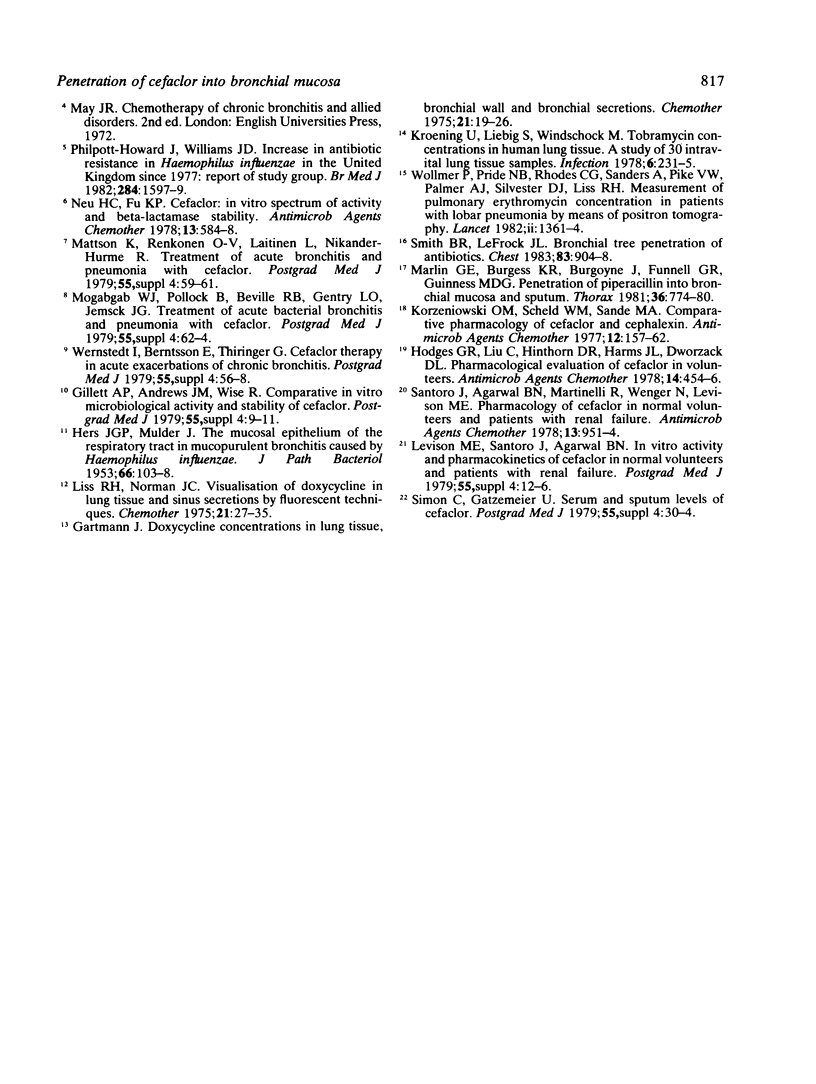Abstract
Bronchial mucosal biopsy specimens were obtained during fibreoptic bronchoscopy in 30 patients receiving a new oral cephalosporin antibiotic, cefaclor (10 had 250 mg, 10 had 500 mg, and 10 had 1000 mg every eight hours). In 10 patients (from all dosage groups) cefaclor was undetectable in the bronchial mucosa but in every case the serum concentration was low, suggesting incomplete absorption. The mean (SD) bronchial mucosal concentration after 250 mg was 3.78 (1.77) micrograms/g (range 2.1-5.8 micrograms/g, n = 4), after 500 mg 4.43 (2.04) micrograms/g (range 2.0-7.1 micrograms/g, n = 8), and after 1000 mg 7.73 (2.76) micrograms/g (range 5.0-12.7 micrograms/g, n = 6). A significantly higher concentration in the bronchial mucosa was achieved with 1000 mg than with 250 mg (p less than 0.05) or 500 mg (p less than 0.025). These concentrations should be effective against Streptococcus pneumoniae, most strains being inhibited below 1.0 microgram/ml. The concentrations were within one dilution of the minimal inhibitory concentration for Haemophilus influenzae, most strains being inhibited below 4.0 micrograms/ml. Some strains of H influenzae will not be inhibited by the concentrations of cefaclor found in the bronchial mucosa, particularly those that are ampicillin resistant.
Full text
PDF




Selected References
These references are in PubMed. This may not be the complete list of references from this article.
- Bill N. J., Washington J. A., 2nd Comparison of in vitro activity of cephalexin, cephradine, and cefaclor. Antimicrob Agents Chemother. 1977 Mar;11(3):470–474. doi: 10.1128/aac.11.3.470. [DOI] [PMC free article] [PubMed] [Google Scholar]
- Gartmann J. Doxycycline concentrations in lung tissue, bronchial wall, and bronchial secretions. Chemotherapy. 1975;21 (Suppl 1):19–26. doi: 10.1159/000221888. [DOI] [PubMed] [Google Scholar]
- Gillett A. P., Andrews J. M., Wise R. Comparative in vitro microbiological activity and stability of cefaclor. Postgrad Med J. 1979;55 (Suppl 4):9–11. [PubMed] [Google Scholar]
- HERS J. F., MULDER J. The mucosal epithelium of the respiratory tract in muco-purulent bronchitis caused by Haemophilus influenzae. J Pathol Bacteriol. 1953 Jul;66(1):103–108. doi: 10.1002/path.1700660114. [DOI] [PubMed] [Google Scholar]
- Hodges G. R., Liu C., Hinthorn D. R., Harms J. L., Dworzack D. L. Pharmacological evaluation of cefaclor in volunteers. Antimicrob Agents Chemother. 1978 Sep;14(3):454–456. doi: 10.1128/aac.14.3.454. [DOI] [PMC free article] [PubMed] [Google Scholar]
- Korzeniowski O. M., Scheld W. M., Sande M. A. Comparative pharmacology of cefaclor and cephalexin. Antimicrob Agents Chemother. 1977 Aug;12(2):157–162. doi: 10.1128/aac.12.2.157. [DOI] [PMC free article] [PubMed] [Google Scholar]
- Kroening U., Liebig S., Wundschock M. Tobramycin-Spiegel im menschlichen Lungengewebe. Infection. 1978;6(5):231–235. doi: 10.1007/BF01642315. [DOI] [PubMed] [Google Scholar]
- Liss R. H., Norman J. C. Visualization of doxycycline in lung tissue and sinus secretions by fluorescent techniques. Chemotherapy. 1975;21 (Suppl 1):27–35. doi: 10.1159/000221889. [DOI] [PubMed] [Google Scholar]
- Marlin G. E., Burgess K. R., Burgoyne J., Funnell G. R., Guinness M. D. Penetration of piperacillin into bronchial mucosa and sputum. Thorax. 1981 Oct;36(10):774–780. doi: 10.1136/thx.36.10.774. [DOI] [PMC free article] [PubMed] [Google Scholar]
- Mattson K., Renkonen O. V., Laitinen L., Nikander-Hurme R. Treatment of acute bronchitis and pneumonia with cefaclor. Postgrad Med J. 1979;55 (Suppl 4):59–61. [PubMed] [Google Scholar]
- Neu H. C., Fu K. P. Cefaclor: in vitro spectrum of activity and beta-lactamase stability. Antimicrob Agents Chemother. 1978 Apr;13(4):584–588. doi: 10.1128/aac.13.4.584. [DOI] [PMC free article] [PubMed] [Google Scholar]
- Philpott-Howard J., Williams J. D. Increase in antibiotic resistance in Haemophilus influenzae in the United Kingdom since 1977: report of study group. Br Med J (Clin Res Ed) 1982 May 29;284(6329):1597–1599. doi: 10.1136/bmj.284.6329.1597. [DOI] [PMC free article] [PubMed] [Google Scholar]
- Sanders C. In vitro studies with cefaclor, a new oral cephalosporin. Antimicrob Agents Chemother. 1977 Oct;12(4):490–497. doi: 10.1128/aac.12.4.490. [DOI] [PMC free article] [PubMed] [Google Scholar]
- Santoro J., Agarwal B. N., Martinelli R., Wenger N., Levison M. E. Pharmacology of cefaclor in normal volunteers and patients with renal failure. Antimicrob Agents Chemother. 1978 Jun;13(6):951–954. doi: 10.1128/aac.13.6.951. [DOI] [PMC free article] [PubMed] [Google Scholar]
- Smith B. R., LeFrock J. L. Bronchial tree penetration of antibiotics. Chest. 1983 Jun;83(6):904–908. doi: 10.1378/chest.83.6.904. [DOI] [PubMed] [Google Scholar]
- Wollmer P., Pride N. B., Rhodes C. G., Sanders A., Pike V. W., Palmer A. J., Silvester D. J., Liss R. H. Measurement of pulmonary erythromycin concentration in patients with lobar pneumonia by means of positron tomography. Lancet. 1982 Dec 18;2(8312):1361–1364. doi: 10.1016/s0140-6736(82)91269-7. [DOI] [PubMed] [Google Scholar]


